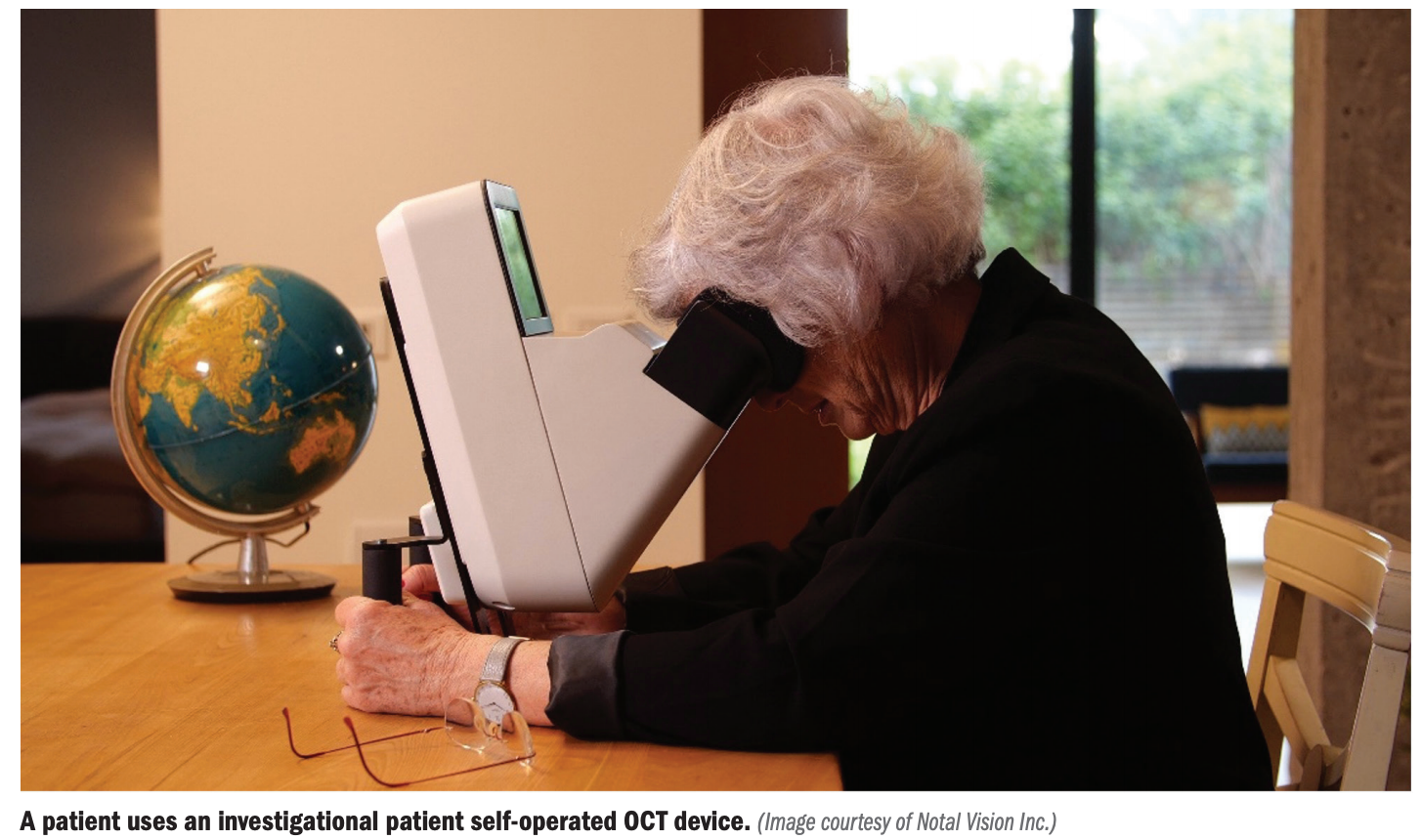News
Article
Digital Edition
In-home self-monitoring of AMD patients identifies retinal fluid
Author(s):
Rapid fluid identification may result in better visual outcomes.

This article was reviewed by Anat Loewenstein, MD
High-quality retinal images obtained by patients in their homes using a self-operated optical coherence tomography (OCT) system (Notal Vision Home OCT; Notal Vision) were suitable for reliable identification of retinal fluid by human graders and quantification by an artificial intelligence (AI)-based algorithm, according to Anat Loewenstein, MD.
This conclusion was based on a study conducted by Loewenstein and colleagues to determine how well an OCT system designed for at-home use works. Their goal was to “catch and treat” wet retinas as soon as possible.
Related: Risk awareness helps identify medication-induced retinal toxicity
Loewenstein is the director of the Division of Ophthalmology at Tel Aviv Medical Center, vice dean of the Sackler Faculty of Medicine at Tel Aviv University in Israel, and president of the Israeli Ophthalmological Society.
“Home OCT has great potential for personalizing the management of newly developed age-related macular degeneration [AMD],” she said. “Using home OCT monitoring, we are trying to catch and treat wet days as soon as they happen.”
Monitoring has benefits including the prevention of undertreatment, improved visual acuity outcomes, reduction of the patient burden, increased satisfaction, and reduced costs.
Home monitoring also fills the need for continuous vigilance during the coronavirus disease 2019 (COVID-19) pandemic that has severely interrupted routine patient treatment.
Related: Teaching AI algorithms to identify corneal pathology: The future is now
Loewenstein said optimal functioning of a home OCT system depends on 4 requirements:
> Patients must be able to self-image on an OCT device.
> The daily image analysis must be automated and accurate.
> The device must be inexpensive and deliver high-quality images.
> A remote clinic must monitor patient adherence.
Notal Home OCT feasibility study
With those requirements in mind, the investigators conducted a study first to evaluate how well elderly patients with AMD operated the Notal Home OCT system and, second, to compare investigator image assessment of disease activity between the at-home system and commercial in-office OCT devices.
The study included consecutive eyes with dry and wet AMD and 20/400 or better vision.
Related: The state of dry, wet AMD in 2021
A Cirrus (Carl Zeiss Meditec) or Spectralis OCT (Heidelberg Engineering) was used to image the retinas of patients that were not dilated; following a short instruction period on use of the at-home device, the patients then used 2 generations of the Notal Home OCT, a prototype (V2.5) and the next generation commercial form-factor device (V3), to image their own eyes.
A masked reader compared the images from the Notal Home OCT with those from the commercial in-office instrument and looked for intraretinal and subretinal fluid in the central 10° of the macula in 88 B-scans with 34-μm spacing, Loewenstein recounted.
A total of 309 patients (538 eyes) participated in the study, which resulted in 805 scans; 469 eyes (88%) and 69 eyes (93%), respectively, were imaged using the V2.5 and V3.
Related: Visualization with en face OCT offers value for ophthalmologists
The results indicated that the ability to self-image was better in patients with vision exceeding 20/320 compared with those who failed the self-imaging evaluation. Using the V2.5 and V3, about 67% received diagnoses of neovascular AMD and 80% to 90%, respectively, had 20/80 or better vision.
A comparison of the results from the V2.5 and V3 regarding the positive percent agreement (PPA) and negative percent agreement (NPA) for detecting fluid in the images were about 98% and 96%, respectively.
The agreement percentages for identifying subretinal and intraretinal fluid all exceeded 90%.
The PPA and NPA of fluid identification in at least 1 of 3 consecutive V3 images compared with a commercial unit were 97% and 95%, respectively.
Other technologic requirements
The daily image analysis must be automated and accurate to be functional, Loewenstein noted.
The B-scans produced by the Notal OCT Analyzer are segmented by AI to view the internal limiting membrane and retinal pigment epithelium. The fluid volume is quantified and a fluid thickness map is provided.
Related: Noninvasive angiography with OCT offers definite value
The investigators concluded that the PPA and NPA agreement in the Notal Home OCT V3 self-images was comparable to that achieved with commercial in-office OCT instruments, and the retinal fluid identified in the images produced by the Notal OCT results from the tight 34-μm spacing between the B-scans.
--
Anat Loewenstein, MD
e:anatl@tlvmc.gov.il
Loewenstein is a consultant to Notal Vision. The device discussed is not cleared for use by the United States Food and Drug Administration.

Newsletter
Don’t miss out—get Ophthalmology Times updates on the latest clinical advancements and expert interviews, straight to your inbox.





